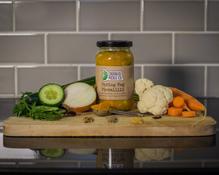
Crooked Pickle Co’s Simple Guide to Pickling
Autumn has well and truly arrived, so it’s time to embrace these darker nights, the beautiful copper tones of the leaves, long autumnal walks and cosying up in front of the fire.
This month at Crooked Pickle Co, we’re sharing with you our handy guide to pickling.
It’s the start of a series of blogs that will delve a little deeper into the different aspects of pickling, the benefits of it and just what you can and can’t pickle.
It’s the perfect time of year to start pickling.
First of all, there’s an abundance of lovely fresh produce available, just waiting to be pickled, stored and savoured over the coming winter months. Secondly, with a tendency for us to cook more hearty and rich food over the Autumn and Winter months, adding a side of pickled anything, helps to cut through the richness of these dishes.
It’s a perfect food pairing.
So let's start with the basics:
Crooked Pickle’s simple guide to pickling
You might be asking…
Why Pickle?
Well, first, and perhaps foremost, humans have been pickling food forever and a day. This food preservation technique dates back thousands of years when preserving perishable food was essential for surviving long winters.
Today, pickling foods is much more than a simple preservation process.
We still pickle to preserve, but thankfully for most of us in today’s world, it’s no longer a matter of survival, but more a desire for tasty pickled and preserved food that can be kept in storage for longer periods whilst maintaining delicious flavour and form.
The basic sour taste of a pickle is a result of the chemical reaction between the food sugars and the naturally present bacteria, but you can change the taste and the texture of your produce depending on how long you leave your pickles and what you use to pickle your products. For instance, your preference might be for a more spicy flavour, or perhaps a more acidic pickle.
Pickling in contrast to fermentation
It’s easy to confused between pickled and fermented foods, as both processes result in a sour-tasting end product.
Pickling relies on immersing foods in an acidic solution (usually vinegar) to produce a sour taste. (One of the simplest ways of pickling is to bring vinegar, sugar and salt to a boil and to pour over your chosen produce before leaving to soak). Think of pickled onions and cauliflower.
Fermentation on the other hand is a natural reaction between natural food bacteria and sugars without the need to use acid (sometimes using just salt will do). During the fermentation process, these natural bacterias convert into acid.
Lacto-fermentation is a process brought on through the presence of lactobacillus, giving fermented foods and drinks their signature taste (tangy and sour), it also creates probiotics, that are commonly thought to aid digestion.
Examples of fermented foods are sauerkraut, kimchi and kombucha amongst others.
What are the most successful foods to pickle?
You can pickle almost all vegetables, including traditional pickled onions, pickled beetroot, pickled cauliflower and of course pickled cabbage. But beyond the classic pickled veg, there’s a whole heap of fruits as well as vegetables that respond brilliantly to the pickling process… carrots, cherries, grapes and even strawberries…the list is truly endless.
We’re proud to provide a wide selection of delicious pickled products here at Crooked Pickle Co, including our award-winning bread and butter pickles
Click here to see our full range.
- #2021
- #Award winning
- #award winning pickles
- #Bread & Butter Pickles
- #buy local
- #Cheese and Pickle
- #cheeseboard favourites
- #Cheeseboard pickles
- #Christmas foodie gifts
- #Christmas gifts
- #Derbyshire Food produce
- #environmentally friendly
- #Guild of FineFoods
- #How to pickle?
- #Korean Pickled Garlic
- #nothing artificial
- #pickled
- #Taste sensation